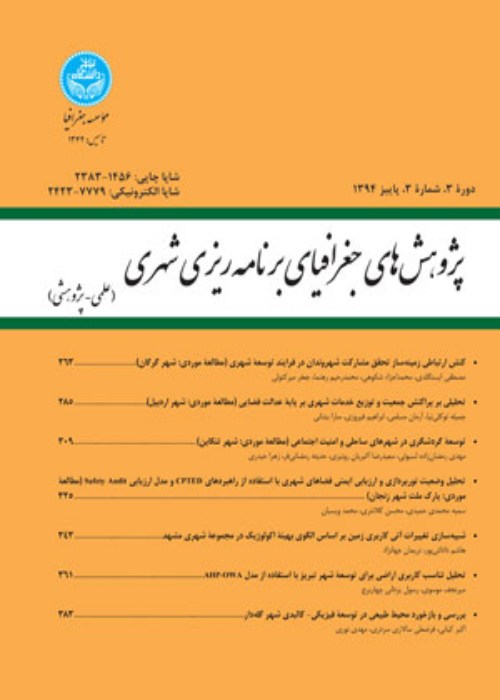Evaluation of sensory preferences affecting users' sense of place in Bazaar of Tabriz (Iran)
Markets have been one of the most essential spaces in the urban body, which have received much attention from many audiences and have high dynamics. The present study aims to identify the indicators of the sensory preference components affecting the sense of place attachment of users in the historical Bazaar of Tabriz to pave the ground for survival and permanence and enhance the link between the architectural heritage and its users. This paper is applied in terms of purpose and conducted by descriptive survey method in terms of nature in the historical Bazaar of Tabriz (Iran). The data collection measures include documentary studies and written sources, objective observations, field studies, and questionnaires (384). SPSS 20 and Amos 24 software were applied to analyze each variable's main components. The study results show that 75% of the variability of the place sense can be predicted based on the variables of sensory preferences. The auditory variables include human voice, music sound, mechanical sound, artificial smell, natural smell, touch, including functional and instrumental, and vision, consisting of coherence, complexity, and mystery, which are significant at less than 0.05. The present research helps designers and urban planners solve the problems of the relationship between humans and the environment from a psychological perspective. This improves such spaces' environmental and social quality, survival, and durability
Markets are one of the most important public spaces in the urban body, which includes a wide range of uses, economic, social, religious, and cultural activities, which creates an environment with identity besides responding to the needs of the users and audience by creating meaning and improving quality. The Bazaar of Tabriz is the historical center of northwest Iran, and it was considered one of the important commercial centers of Iran throughout history. It has always received much attention from architects, researchers, tourists, and experts. Today, the design of architectural spaces, including markets, has been changed considerably. In their planning, new lines of thought affected by various sciences, such as environmental psychology, have been introduced. The Sense of Place is one of the most important factors in the stability of markets, both physically and semantically, and it has a considerable impact on the liveliness and dynamism of these places. The sense of place has become a sacrifice for the place by going to deeper levels of commitment and plays a crucial role in the production of meaning by deepening the sensory link of the audience with the buildings. A review of the theoretical basics shows that the sense of place, which has various dimensions and components, is one of the key elements for the stability of the urban context. By examining the sensory preferences affecting users' sense of place in urban spaces and identifying the relevant key elements, it is possible to improve the level of the users' sense of place and pave the way for the sustainability of the historical urban context. Despite the studies conducted in the field of users' sense of place, the number of studies performed in the field of the survival of historical buildings through maintaining and enhancing the links between the audience and the place is limited, and most of the researches emphasize on the physical dimension; therefore, considering the importance of user behavior in attaining architectural goals, the present study can be a basis for other future researches in this field. The historical Bazaar of Tabriz should be considered as one of the main goals of managers and experts of architectural heritage to ensure its continued survival and durability with exact and appropriate planning and enhancing the quality of the market.
The present study is applied in terms of purpose and descriptive survey method in terms of nature in the historical Bazaar of Tabriz. To measure the reliability of the questionnaire, Cronbach's alpha method was used in SPSS22 software. The sample size was calculated based on the Cochran formula of 384 people, and the questionnaire distribution in the study area was systematically random. The relationship and impact of the variables were analyzed using the structural equation system (SEM) and the Amos24 software.
The standard coefficient between sensory preferences and sense of place is 0.830, according to the absolute value of its t-statistic, as 7.488 and greater than 1.96. Thus, with a probability of 95%, the null hypothesis is not verified, and the H1 is confirmed. It means that sensory preferences have a positive and significant impact on the sense of place (significance = 0.001; β = 0.830), and for a one-unit increase in sensory preferences, the sense of place increases by 0.830 units.
Based on the analyses performed in the historical Bazaar of Tabriz, about 75% of the variability of the sense of place can be predicted by the variables of sensory preferences and the variables of human voice, musical sound, mechanical sound, artificial and natural smell, touch including functional and instrumental, vision consisting of coherence, complexity, and mystery are significant at the level less than 0.05. studies of the market show that among the components of sensory preferences, the visual component with the indicators of "readability," "complexity," "coherence," and "mystery" is the most effective, and the taste component with the index of "quality" has the least impact. In the users' sense of place component, the social components with the sub-components of "the existence of meeting place" and "expected behavior" are the most effective, and the physical component with the components of "design style," "sustainability," "enclosure," and "invitation" have had the least impact. Thus, based on the obtained results, the role of sensory preferences in understanding the environment and creating a sense of place for users is extensive. Designers and managers of commercial spaces can do things such as clarity of spaces and uses, easy access to all spaces, lighting Suitable for day and night, using a mysterious spatial structure to increase people's sense of curiosity, having a map to know the location in the environment, using the sound of music and reducing disturbing mechanical sounds, using natural plants and smell specific to each store, and also increasing the possibility of touching and examining the goods, as well as the existence of cafes and restaurants for sitting and resting, while improving the sense of place of the users, provide the grounds for the sustainability of such spaces and help city managers and professionals in protecting architectural heritage.
- حق عضویت دریافتی صرف حمایت از نشریات عضو و نگهداری، تکمیل و توسعه مگیران میشود.
- پرداخت حق اشتراک و دانلود مقالات اجازه بازنشر آن در سایر رسانههای چاپی و دیجیتال را به کاربر نمیدهد.



